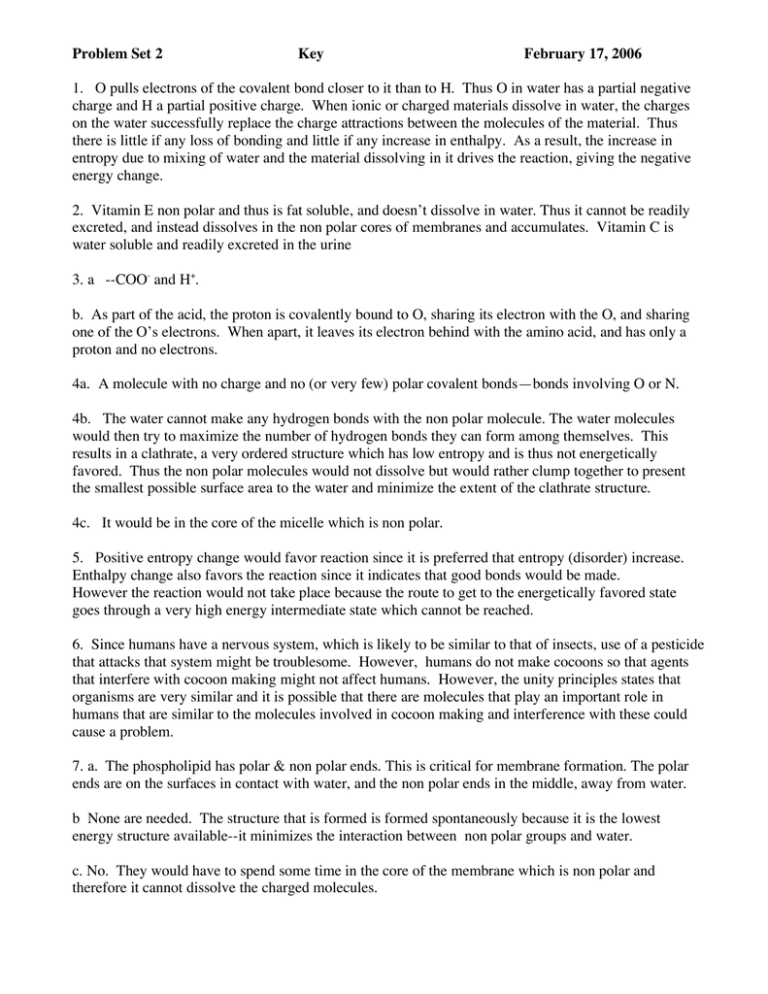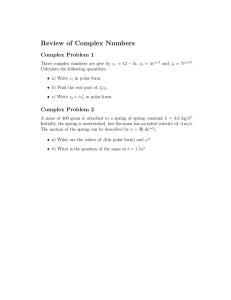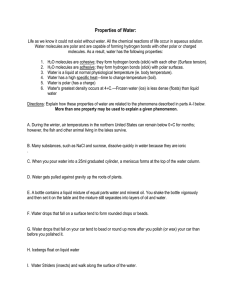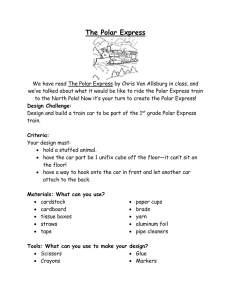Problem Set 2 Key February 17, 2006 1. O pulls electrons of the
advertisement

Problem Set 2 Key February 17, 2006 1. O pulls electrons of the covalent bond closer to it than to H. Thus O in water has a partial negative charge and H a partial positive charge. When ionic or charged materials dissolve in water, the charges on the water successfully replace the charge attractions between the molecules of the material. Thus there is little if any loss of bonding and little if any increase in enthalpy. As a result, the increase in entropy due to mixing of water and the material dissolving in it drives the reaction, giving the negative energy change. 2. Vitamin E non polar and thus is fat soluble, and doesn’t dissolve in water. Thus it cannot be readily excreted, and instead dissolves in the non polar cores of membranes and accumulates. Vitamin C is water soluble and readily excreted in the urine 3. a --COO- and H+. b. As part of the acid, the proton is covalently bound to O, sharing its electron with the O, and sharing one of the O’s electrons. When apart, it leaves its electron behind with the amino acid, and has only a proton and no electrons. 4a. A molecule with no charge and no (or very few) polar covalent bonds—bonds involving O or N. 4b. The water cannot make any hydrogen bonds with the non polar molecule. The water molecules would then try to maximize the number of hydrogen bonds they can form among themselves. This results in a clathrate, a very ordered structure which has low entropy and is thus not energetically favored. Thus the non polar molecules would not dissolve but would rather clump together to present the smallest possible surface area to the water and minimize the extent of the clathrate structure. 4c. It would be in the core of the micelle which is non polar. 5. Positive entropy change would favor reaction since it is preferred that entropy (disorder) increase. Enthalpy change also favors the reaction since it indicates that good bonds would be made. However the reaction would not take place because the route to get to the energetically favored state goes through a very high energy intermediate state which cannot be reached. 6. Since humans have a nervous system, which is likely to be similar to that of insects, use of a pesticide that attacks that system might be troublesome. However, humans do not make cocoons so that agents that interfere with cocoon making might not affect humans. However, the unity principles states that organisms are very similar and it is possible that there are molecules that play an important role in humans that are similar to the molecules involved in cocoon making and interference with these could cause a problem. 7. a. The phospholipid has polar & non polar ends. This is critical for membrane formation. The polar ends are on the surfaces in contact with water, and the non polar ends in the middle, away from water. b None are needed. The structure that is formed is formed spontaneously because it is the lowest energy structure available--it minimizes the interaction between non polar groups and water. c. No. They would have to spend some time in the core of the membrane which is non polar and therefore it cannot dissolve the charged molecules. d. No. Amino acids carry a (+ ) charge on the amino group, having picked up an extra proton, and a ( - ) charge on the acid group which has lost a proton. Thus they cannot penetrate the non polar membrane. 8. a. The bond linking the OH group on the acid and the H on the amino group must be broken to create the water and allow the amino acids to link. b. After the bonds break , others are formed: HO & H form water & the 2 amino acids join as a dipeptide. 9. Primary - the sequence of amino acids in a single protein chain. Secondary structure involves the problem created by the polar N-H and C=O groups on the protein backbone (not side chains) when they are brought into the non-polar core of the protein because the nearby side chains are non-polar. Tertiary - the 3D structure of a single protein chain resulting from its folding, twisting, turning etc in space. Quaternary - the structure of a protein that has more than one protein subunit or that has a non protein molecule or atom associated with a protein subunit. b. Subunits are held together by hydrogen bonds, +, - attractive forces, non polar interactions. Thus a change in any of these would weaken the attraction. For example, a replacement of a positively charged amino acid on one subunit that is binding to a negatively charged amino acid on another subunit by a neutral amino acid would result in the loss of the +,- interaction and weaken the subunit-subunit bonding.




